Methodology for Measuring the Cutting Inserts Wear
Abstract
:1. Introduction
2. State of the Art
2.1. The Wear of Cutting Tools and Tool Life
2.2. Cutting Tool Wear Measurement Methods
2.2.1. On-Line Methods
Direct Tool Condition Monitoring
Indirect Tool Condition Monitoring
- a.
- Cutting force
- b.
- Vibration
- c.
- Acoustic emission and cutting sound
- d.
- Motor current and spindle power
- e.
- Machined surface roughness
- f.
- Other methods for indirect wear monitoring
2.2.2. Off-Line Methods
2.3. Conclusions Regarding Literature Review
3. Materials and Methods
4. Results and Discussions
4.1. Identify Sources of Human Error When Measuring Wear
4.2. Determination of Operator-Induced Measurement Error
- maximum difference between readings is 0.031 mm at points 6, 13, 22 and 26, which means that at these points it is more difficult to notice the transition from relief face to wear;
- maximum difference between the average wears is 0.0106 mm, which is more than acceptable;
- all repeats indicated maximum wear in point 9.
4.3. Difference between Measurements Made by Independent Operators
- maximum difference for the measured wear values by operators is 0.068 mm at point 1, which is understandable, being the first measurement; already when measuring the wear in point 2 the difference was reduced to 0.059 mm and then it returned to normal, the difference being as for the first operator, when 12 repetitions were performed;
- maximum difference between the average wears for the six operators is 0.008 mm, which is more than acceptable;
- repeats indicated maximum wear in point 9;
- the points where the transition appreciation from the unworn surface to the worn surface was made with greater difficulty were, namely, points 1, 2, 6, 10, 19, 22 and 25.
4.4. Methodology for Measuring the Flank Wear
- Step 1. Identify the characteristics of the worn cutting insert, especially the nose radius;
- Step 2. Identify the characteristics of the cutting tool holder, first of all of the front clearance angle when positioning on the machine tool;
- Step 3. Position the insert on the microscope table so that the wear on the flank is visible perpendicularly;
- Step 4. Microscopic measurement of the M dimension to determine the worn rectilinear edge Lx (Figure 13);
- Step 5. Determine the number of points on the rectilinear edge where the wear on the flank will be measured (Section 4), the increment being p = 0.1 mm;
- Step 6. Position the horizontal reticle of the microscope along the unworn edge;
- Step 7. Position the vertical reticle of the microscope at the end of wear so that the measurements are made towards the tip of the cutting tool (in this way the nose radius of the cutting insert is avoided—Figure 14);
- Step 8. Wear measurement at each point identified in step 5;
- Step 9. Identify the maximum flank wear VBMAX;
- Step 10. Calculate of the average wear VBB taking into account the maximum value;
- Step 11. Calculate of the ratio between maximum wear and average wear, a ratio that characterizes the degree of non-uniformity of wear.
4.5. Applying the Principles of Symmetry to Characterize the Wear
5. Conclusions
- This paper, in the state of the art section, presented the actual methods used to assess the wear of cutting tools, centralizing 88 researches and studies over the last decade;
- It highlighted the importance of continuous research in the wear of cutting tools field and also the necessity of a unitary methodology of measurement;
- In this paper is proposed a unitary methodology for measuring wear by microscope so that researchers can obtain comparable values; this methodology can be applied with a level of confidence argued by experimental attempts;
- The development of the proposed methodology requires experimental tries to identify the errors that may occur during the wear measurement; this research also identifies and analyzes the sources of human error in measuring the flank wear;
- The obtained experimental data show the magnitude of the errors that can be made by an operator and also by independent operators when measuring the flank wear;
- The methodology was tested in the case of six worn inserts SPMR150612 type, and from each insert was used one cutting edge for turning C45(1.0503) specimens;
- In a separate section, based on the experimental data, the principles of symmetry were applied and is demonstrated that the wear has a pronounced ununiform character;
- The proposed methodology used to measure the flank wear of the cutting inserts with minimal errors, allows for the collection of results which can be compared between different researchers and can also be easily reproduced.
Author Contributions
Funding
Institutional Review Board Statement
Informed Consent Statement
Data Availability Statement
Conflicts of Interest
References
- Siddhpura, A.; Paurobally, R. A review of flank wear prediction methods for tool condition monitoring in a turning process. Int. J. Adv. Manuf. Technol. 2013, 65, 371–393. [Google Scholar] [CrossRef]
- Zhu, D.; Zhang, X.; Ding, H. Tool wear characteristics in machining of nickel-based superalloys. Int. J. Mach. Tools Manuf. 2013, 64, 60–77. [Google Scholar] [CrossRef]
- Xu, C.; Dou, J.; Chai, Y.; Li, H.; Shi, Z.; Xu, J. The relationships between cutting parameters, tool wear, cutting force and vibration. Adv. Mech. Eng. 2018, 10, 1687814017750434. [Google Scholar] [CrossRef]
- International Organization of Standardization. Available online: www.iso.org/standard/9151 (accessed on 1 February 2022).
- Daicu, R.; Dițu, V. Particularities Regarding the Wear of SPMR150612-P30 Metallic Carbide Inserts. Recent J. 2019, 20, 123–128. [Google Scholar] [CrossRef]
- Attanasio, A.; Ceretti, E.; Fiorentino, A.; Cappellini, C.; Giardini, C. Investigation and FEM-based simulation of tool wear in turning operations with uncoated carbide tools. Wear 2010, 269, 344–350. [Google Scholar] [CrossRef]
- Haddag, B.; Nouari, M. Tool wear and heat transfer analyses in dry machining based on multi-steps numerical modelling and experimental validation. Wear 2013, 302, 1158–1170. [Google Scholar] [CrossRef]
- Binder, M.; Klocke, F.; Lung, D. Tool wear simulation of complex shaped coated cutting tools. Wear 2015, 330–331, 600–607. [Google Scholar] [CrossRef]
- Pimenov, D.Y.; Guzeev, V.I. Mathematical model of plowing forces to account for flank wear using FME modeling for orthogonal cutting scheme. Int. J. Adv. Manuf. Technol. 2016, 89, 3149–3159. [Google Scholar] [CrossRef]
- Shi, Z.; Li, X.; Duan, N.; Yang, Q. Evaluation of tool wear and cutting performance considering effects of dynamic nodes movement based on FEM simulation. Chin. J. Aeronaut. 2020, 34, 140–152. [Google Scholar] [CrossRef]
- Dutta, S.; Pal, S.K.; Sen, R. Digital Image Processing in Machining. In Modern Mechanical Engineering. Materials Forming, Machining and Tribology; Davim, J.P., Ed.; Springer: Berlin/Heidelberg, Germany, 2014; Chapter 13; pp. 367–410. [Google Scholar] [CrossRef]
- Wang, W.; Wong, Y.; Hong, G. Flank wear measurement by successive image analysis. Comput. Ind. 2005, 56, 816–830. [Google Scholar] [CrossRef]
- Zhang, C.; Zhang, J. On-line tool wear measurement for ball-end milling cutter based on machine vision. Comput. Ind. 2013, 64, 708–719. [Google Scholar] [CrossRef]
- Li, W.; Singh, H.M.; Guo, Y.B. An online optical system for inspecting tool condition in milling of H13 tool steel and IN 718 alloy. Int. J. Adv. Manuf. Technol. 2012, 67, 1067–1077. [Google Scholar] [CrossRef]
- Zhu, K.; Yu, X. The monitoring of micro milling tool wear conditions by wear area estimation. Mech. Syst. Signal Process. 2017, 93, 80–91. [Google Scholar] [CrossRef]
- Szydłowski, M.; Powalka, B.; Matuszak, M.; Kochmański, P. Machine vision micro-milling tool wear inspection by image reconstruction and light reflectance. Precis. Eng. 2016, 44, 236–244. [Google Scholar] [CrossRef]
- Li, L.; An, Q. An in-depth study of tool wear monitoring technique based on image segmentation and texture analysis. Measurement 2016, 79, 44–52. [Google Scholar] [CrossRef]
- Takaya, Y.; Maruno, K.; Michihata, M.; Mizutani, Y. Measurement of a tool wear profile using confocal fluorescence microscopy of the cutting fluid layer. CIRP Ann. 2016, 65, 467–470. [Google Scholar] [CrossRef]
- Čerče, L.; Pušavec, F.; Kopač, J. 3D cutting tool-wear monitoring in the process. J. Mech. Sci. Technol. 2015, 29, 3885–3895. [Google Scholar] [CrossRef]
- D’Addona, D.M.; Ullah, A.S.; Matarazzo, D. Tool-wear prediction and pattern-recognition using artificial neural network and DNA-based computing. J. Intell. Manuf. 2015, 28, 1285–1301. [Google Scholar] [CrossRef]
- Lipiński, D.; Kacalak, W.; Tomkowski, R. Methodology of evaluation of abrasive tool wear with the use of laser scanning microscopy. Scanning 2013, 36, 53–63. [Google Scholar] [CrossRef]
- Zhang, C.; Yao, X.; Zhang, J.; Jin, H. Tool Condition Monitoring and Remaining Useful Life Prognostic Based on a Wireless Sensor in Dry Milling Operations. Sensors 2016, 16, 795. [Google Scholar] [CrossRef] [Green Version]
- Ghani, J.; Rizal, M.; Nuawi, M.; Ghazali, M.; Haron, C. Monitoring online cutting tool wear using low-cost technique and user-friendly GUI. Wear 2011, 271, 2619–2624. [Google Scholar] [CrossRef]
- Nouri, M.; Fussell, B.K.; Ziniti, B.L.; Linder, E. Real-time tool wear monitoring in milling using a cutting condition independent method. Int. J. Mach. Tools Manuf. 2014, 89, 1–13. [Google Scholar] [CrossRef]
- Singh, D.; Rao, P.V. Flank wear prediction of ceramic tools in hard turning. Int. J. Adv. Manuf. Technol. 2010, 50, 479–493. [Google Scholar] [CrossRef]
- Jozić, S.; Lela, B.; Bajić, D. A New Mathematical Model for Flank Wear Prediction Using Functional Data Analysis Methodology. Adv. Mater. Sci. Eng. 2014, 2014, 138168. [Google Scholar] [CrossRef] [Green Version]
- Denkena, B.; Krüger, M.; Schmidt, J. Condition-based tool management for small batch production. Int. J. Adv. Manuf. Technol. 2014, 74, 471–480. [Google Scholar] [CrossRef]
- Chinchanikar, S.; Choudhury, S.K. Cutting force modeling considering tool wear effect during turning of hardened AISI 4340 alloy steel using multi-layer TiCN/Al2O3/TiN-coated carbide tools. Int. J. Adv. Manuf. Technol. 2015, 83, 1749–1762. [Google Scholar] [CrossRef]
- Jeyakumar, S.; Marimuthu, K.; Ramachandran, T. Prediction of cutting force, tool wear and surface roughness of Al6061/SiC composite for end milling operations using RSM. J. Mech. Sci. Technol. 2013, 27, 2813–2822. [Google Scholar] [CrossRef]
- Wang, G.; Guo, Z.; Qian, L. Tool wear prediction considering uncovered data based on partial least square regression. J. Mech. Sci. Technol. 2014, 28, 317–322. [Google Scholar] [CrossRef]
- Kaya, B.; Oysu, C.; Ertunc, H.M. Force-torque based on-line tool wear estimation system for CNC milling of Inconel 718 using neural networks. Adv. Eng. Softw. 2011, 42, 76–84. [Google Scholar] [CrossRef]
- Rizal, M.; Ghani, J.A.; Nuawi, M.Z.; Haron, C.H.C. Online tool wear prediction system in the turning process using an adaptive neuro-fuzzy inference system. Appl. Soft Comput. 2013, 13, 1960–1968. [Google Scholar] [CrossRef]
- Liu, T.-I.; Song, S.-D.; Liu, G.; Wu, Z. Online monitoring and measurements of tool wear for precision turning of stainless steel parts. Int. J. Adv. Manuf. Technol. 2012, 65, 1397–1407. [Google Scholar] [CrossRef]
- Wang, G.; Cui, Y. On line tool wear monitoring based on auto associative neural network. J. Intell. Manuf. 2012, 24, 1085–1094. [Google Scholar] [CrossRef]
- Gao, D.; Liao, Z.; Lv, Z.; Lu, Y. Multi-scale statistical signal processing of cutting force in cutting tool condition monitoring. Int. J. Adv. Manuf. Technol. 2015, 80, 1843–1853. [Google Scholar] [CrossRef]
- Benkedjouh, T.; Medjaher, K.; Zerhouni, N.; Rechak, S. Health assessment and life prediction of cutting tools based on support vector regression. J. Intell. Manuf. 2015, 26, 213–223. [Google Scholar] [CrossRef] [Green Version]
- Karam, S.; Centobelli, P.; D’Addona, D.M.; Teti, R. Online Prediction of Cutting Tool Life in Turning via Cognitive Decision Making. Procedia CIRP 2016, 41, 927–932. [Google Scholar] [CrossRef]
- Yang, W.-A.; Zhou, W.; Liao, W.; Guo, Y. Prediction of drill flank wear using ensemble of co-evolutionary particle swarm optimization based-selective neural network ensembles. J. Intell. Manuf. 2014, 27, 343–361. [Google Scholar] [CrossRef]
- Fang, N.; Pai, P.S.; Edwards, N. A comparative study of high-speed machining of Ti-6Al-4V and Inconel 718—part II: Effect of dynamic tool edge wear on cutting vibrations. Int. J. Adv. Manuf. Technol. 2013, 68, 1417–1428. [Google Scholar] [CrossRef]
- Fang, N.; Pai, P.S.; Edwards, N. A method of using Hoelder exponents to monitor tool-edge wear in high-speed finish machining. Int. J. Adv. Manuf. Technol. 2014, 72, 1593–1601. [Google Scholar] [CrossRef]
- Postnov, V.V.; Idrisova, Y.V.; Fetsak, S.I. Influence of machine-tool dynamics on the tool wear. Russ. Eng. Res. 2015, 35, 936–940. [Google Scholar] [CrossRef]
- Rao, K.V.; Murthy, B.; Rao, N.M. Cutting tool condition monitoring by analyzing surface roughness, work piece vibration and volume of metal removed for AISI 1040 steel in boring. Measurement 2013, 46, 4075–4084. [Google Scholar] [CrossRef]
- Rmili, W.; Ouahabi, A.; Serra, R.; Leroy, R. An automatic system based on vibratory analysis for cutting tool wear monitoring. Measurement 2016, 77, 117–123. [Google Scholar] [CrossRef]
- Painuli, S.; Elangovan, M.; Sugumaran, V. Tool condition monitoring using K-star algorithm. Expert Syst. Appl. 2014, 41, 2638–2643. [Google Scholar] [CrossRef]
- Aghdam, B.H.; Vahdati, M.; Sadeghi, M.H. Vibration-based estimation of tool major flank wear in a turning process using ARMA models. Int. J. Adv. Manuf. Technol. 2014, 76, 1631–1642. [Google Scholar] [CrossRef]
- Sun, H.; Zhang, X.; Niu, W. In-process cutting tool remaining useful life evaluation based on operational reliability assessment. Int. J. Adv. Manuf. Technol. 2015, 86, 841–851. [Google Scholar] [CrossRef]
- Kilundu, B.; Dehombreux, P.; Chiementin, X. Tool wear monitoring by machine learning techniques and singular spectrum analysis. Mech. Syst. Signal Process. 2011, 25, 400–415. [Google Scholar] [CrossRef]
- Tratar, J.; Pusavec, F.; Kopac, J. Tool wear in terms of vibration effects in milling medium-density fibreboard with an industrial robot. J. Mech. Sci. Technol. 2014, 28, 4421–4429. [Google Scholar] [CrossRef]
- Salonitis, K.; Kolios, A. Reliability assessment of cutting tool life based on surrogate approximation methods. Int. J. Adv. Manuf. Technol. 2014, 71, 1197–1208. [Google Scholar] [CrossRef] [Green Version]
- Bhuiyan, S.; Choudhury, I.; Dahari, M.; Nukman, Y.; Dawal, S. Application of acoustic emission sensor to investigate the frequency of tool wear and plastic deformation in tool condition monitoring. Measurement 2016, 92, 208–217. [Google Scholar] [CrossRef]
- Kulandaivelu, P.; Kumar, P.S.; Sundaram, S. Wear monitoring of single point cutting tool using acoustic emission tech-niques. Sadhana 2013, 38, 211–234. [Google Scholar]
- Zafar, T.; Kamal, K.; Sheikh, Z.; Mathavan, S.; Ali, U.; Hashmi, M.H. A neural network based approach for background noise reduction in airborne acoustic emission of a machining process. J. Mech. Sci. Technol. 2017, 31, 3171–3182. [Google Scholar] [CrossRef]
- Prakash, M.; Kanthababu, M. In-process tool condition monitoring using acoustic emission sensor in microendmilling. Mach. Sci. Technol. 2013, 17, 209–227. [Google Scholar] [CrossRef]
- Bhuiyan, M.S.H.; Choudhury, I.A.; Dahari, M. Monitoring the tool wear, surface roughness and chip formation occurrences using multiple sensors in turning. J. Manuf. Syst. 2014, 33, 476–487. [Google Scholar] [CrossRef]
- Ren, Q.; Baron, L.; Balazinski, M.; Botez, R.; Bigras, P. Tool wear assessment based on type-2 fuzzy uncertainty estimation on acoustic emission. Appl. Soft Comput. 2015, 31, 14–24. [Google Scholar] [CrossRef]
- Li, H.; Wang, Y.; Zhao, P.; Zhang, X.; Zhou, P. Cutting tool operational reliability prediction based on acoustic emission and logistic regression model. J. Intell. Manuf. 2014, 26, 923–931. [Google Scholar] [CrossRef]
- Bombiński, S.; Błażejak, K.; Nejman, M.; Jemielniak, K. Sensor Signal Segmentation for Tool Condition Monitoring. Procedia CIRP 2016, 46, 155–160. [Google Scholar] [CrossRef] [Green Version]
- Balsamo, V.; Caggiano, A.; Jemielniak, K.; Kossakowska, J.; Nejman, M.; Teti, R. Multi Sensor Signal Processing for Catastrophic Tool Failure Detection in Turning. Procedia CIRP 2016, 41, 939–944. [Google Scholar] [CrossRef]
- Cuka, B.; Kim, D.-W. Fuzzy logic based tool condition monitoring for end-milling. Robot. Comput. Manuf. 2017, 47, 22–36. [Google Scholar] [CrossRef]
- Seemuang, N.; McLeay, T.; Slatter, T. Using spindle noise to monitor tool wear in a turning process. Int. J. Adv. Manuf. Technol. 2016, 86, 2781–2790. [Google Scholar] [CrossRef] [Green Version]
- Zhang, K.-F.; Yuan, H.-Q.; Nie, P. A method for tool condition monitoring based on sensor fusion. J. Intell. Manuf. 2015, 26, 1011–1026. [Google Scholar] [CrossRef]
- Khajavi, M.N.; Nasernia, E.; Rostaghi, M. Milling tool wear diagnosis by feed motor current signal using an artificial neural network. J. Mech. Sci. Technol. 2016, 30, 4869–4875. [Google Scholar] [CrossRef]
- Letot, C.; Serra, R.; Dossevi, M.; Dehombreux, P. Cutting tools reliability and residual life prediction from degradation indicators in turning process. Int. J. Adv. Manuf. Technol. 2015, 86, 495–506. [Google Scholar] [CrossRef]
- Liao, Y.; Stephenson, D.A.; Ni, J. A Multifeature Approach to Tool Wear Estimation Using 3D Workpiece Surface Texture Parameters. J. Manuf. Sci. Eng. 2010, 132, 061008. [Google Scholar] [CrossRef]
- Dutta, S.; Kanwat, A.; Pal, S.K.; Sen, R. Correlation study of tool flank wear with machined surface texture in end milling. Measurement 2013, 46, 4249–4260. [Google Scholar] [CrossRef]
- Dutta, S.; Datta, A.; Das Chakladar, N.; Pal, S.; Mukhopadhyay, S.; Sen, R. Detection of tool condition from the turned surface images using an accurate grey level co-occurrence technique. Precis. Eng. 2012, 36, 458–466. [Google Scholar] [CrossRef]
- Dutta, S.; Pal, S.K.; Sen, R. Progressive tool flank wear monitoring by applying discrete wavelet transform on turned surface images. Measurement 2016, 77, 388–401. [Google Scholar] [CrossRef]
- Dutta, S.; Pal, S.K.; Sen, R. On-machine tool prediction of flank wear from machined surface images using texture analyses and support vector regression. Precis. Eng. 2016, 43, 34–42. [Google Scholar] [CrossRef]
- Bhat, N.N.; Dutta, S.; Vashisth, T.; Pal, S.; Pal, S.K.; Sen, R. Tool condition monitoring by SVM classification of machined surface images in turning. Int. J. Adv. Manuf. Technol. 2016, 83, 1487–1502. [Google Scholar] [CrossRef]
- Senthilkumar, N.; Tamizharasan, T. Experimental investigation of cutting zone temperature and flank wear correlation in turning AISI 1045 steel with different tool geometries. Indian J. Eng. Mater. Sci. 2014, 21, 139–148. Available online: http://nopr.niscair.res.in/bitstream/123456789/28780/3/IJEMS%2021(2)%20139-148.pdf (accessed on 6 February 2022).
- Bagavathiappan, S.; Lahiri, B.B.; Suresh, S.; Philip, J.; Jayakumar, T. Online monitoring of cutting tool temperature during micro-end milling using infrared thermography. Insight Non Destr. Test. Cond. Monit. 2015, 57, 9–17. [Google Scholar] [CrossRef]
- Lauro, C.; Brandão, L.; Baldo, D.; Reis, R.; Davim, J.P. Monitoring and processing signal applied in machining processes—A review. Measurement 2014, 58, 73–86. [Google Scholar] [CrossRef]
- Daicu, R.; Oancea, G. Electrical Current at Metal Cutting Process: A Literature Review. Appl. Mech. Mater. 2015, 808, 40–47. [Google Scholar] [CrossRef]
- Medison, V.V. Influence of thermoelectric current on the tool life in cutting titanium alloys. Russ. Eng. Res. 2014, 34, 235–238. [Google Scholar] [CrossRef]
- Ratava, J.; Lohtander, M.; Varis, J. Tool condition monitoring in interrupted cutting with acceleration sensors. Robot. Comput. Manuf. 2017, 47, 70–75. [Google Scholar] [CrossRef]
- Mandal, N.; Mondal, B.; Doloi, B. Application of Back Propagation Neural Network Model for Predicting Flank Wear of Yttria Based Zirconia Toughened Alumina (ZTA) Ceramic Inserts. Trans. Indian Inst. Met. 2015, 68, 783–789. [Google Scholar] [CrossRef]
- DAS, S.R.; Dhupal, D.; Kumar, A. Study of surface roughness and flank wear in hard turning of AISI 4140 steel with coated ceramic inserts. J. Mech. Sci. Technol. 2015, 29, 4329–4340. [Google Scholar] [CrossRef]
- Li, H.; He, G.; Qin, X.; Wang, G.; Lu, C.; Gui, L. Tool wear and hole quality investigation in dry helical milling of Ti-6Al-4V alloy. Int. J. Adv. Manuf. Technol. 2014, 71, 1511–1523. [Google Scholar] [CrossRef]
- Bushlya, V.M.; Gutnichenko, O.A.; Zhou, J.M.; Ståhl, J.-E.; Gunnarsson, S. Tool wear and tool life of PCBN, binderless cBN and wBN-cBN tools in continuous finish hard turning of cold work tool steel. J. Superhard Mater. 2014, 36, 49–60. [Google Scholar] [CrossRef]
- Chinchanikar, S.; Choudhury, S.K. Wear behaviors of single-layer and multi-layer coated carbide inserts in high speed machining of hardened AISI 4340 steel. J. Mech. Sci. Technol. 2013, 27, 1451–1459. [Google Scholar] [CrossRef]
- Valerga, A.; Batista, M.; Bienvenido, R.; Fernández-Vidal, S.; Wendt, C.; Marcos, M. Reverse Engineering Based Methodology for Modelling Cutting Tools. Procedia Eng. 2015, 132, 1144–1151. [Google Scholar] [CrossRef] [Green Version]
- Cabibbo, M.; Forcellese, A.; Raffaeli, R.; Simoncini, M. Reverse Engineering and Scanning Electron Microscopy Applied to the Characterization of Tool Wear in Dry Milling Processes. Procedia CIRP 2017, 62, 233–238. [Google Scholar] [CrossRef]
- Wang, J.; Wang, P.; Gao, R.X. Enhanced particle filter for tool wear prediction. J. Manuf. Syst. 2015, 36, 35–45. [Google Scholar] [CrossRef]
- Hsu, B.-M.; Shu, M.-H.; Wu, L. Dynamic performance modelling and measuring for machine tools with continuous-state wear processes. Int. J. Prod. Res. 2013, 51, 4718–4731. [Google Scholar] [CrossRef]
- Xu, W.; Cao, L. Optimal tool replacement with product quality deterioration and random tool failure. Int. J. Prod. Res. 2014, 53, 1736–1745. [Google Scholar] [CrossRef]
- Salimiasl, A.; Özdemir, A. Analyzing the performance of artificial neural network (ANN)-, fuzzy logic (FL)-, and least square (LS)-based models for online tool condition monitoring. Int. J. Adv. Manuf. Technol. 2016, 87, 1145–1158. [Google Scholar] [CrossRef]
- Yang, W.-A.; Zhou, Q.; Tsui, K.-L. Differential evolution-based feature selection and parameter optimisation for extreme learning machine in tool wear estimation. Int. J. Prod. Res. 2015, 54, 4703–4721. [Google Scholar] [CrossRef]
- Jafarian, F.; Taghipour, M.; Amirabadi, H. Application of artificial neural network and optimization algorithms for optimizing surface roughness, tool life and cutting forces in turning operation. J. Mech. Sci. Technol. 2013, 27, 1469–1477. [Google Scholar] [CrossRef]
- Ostasevicius, V.; Jurenas, V.; Augutis, V.; Gaidys, R.; Cesnavicius, R.; Kizauskiene, L.; Dundulis, R. Monitoring the condition of the cutting tool using self-powering wireless sensor technologies. Int. J. Adv. Manuf. Technol. 2016, 88, 2803–2817. [Google Scholar] [CrossRef] [Green Version]
- European Steel and Alloy Grades/Numbers. Available online: http://www.steelnumber.com/en/steel_composition_eu.php?name_id=152 (accessed on 1 February 2022).
- Microscope International. Available online: https://microscopeinternational.com/mitutoyo-vision-unit-10d-system-retrofit-microscopes-export/ (accessed on 6 February 2022).
- Shop Mitutoyo. Available online: https://shop.mitutoyo.ro/web/mitutoyo/en_RO/mitutoyo/01.02.07.01/Digital%20Micrometer%20Head/$catalogue/mitutoyoData/PR/164-163/index.xhtml (accessed on 6 February 2022).
- Mitutoyo. Available online: https://www.mitutoyo.se/application/files/8315/5888/7807/PRE13034_Measuring_Microscopes_SMALL.pdf (accessed on 6 February 2022).
- Daicu, R. Innovative Approaches to Metal Cutting. Ph.D. Thesis, Transilvania University of Brasov, Brasov, Romania, July 2021. [Google Scholar]
- Hirox. Available online: https://www.hirox.com/catalog/pdf/cat_RH-2000_en2_A.pdf (accessed on 6 February 2022).

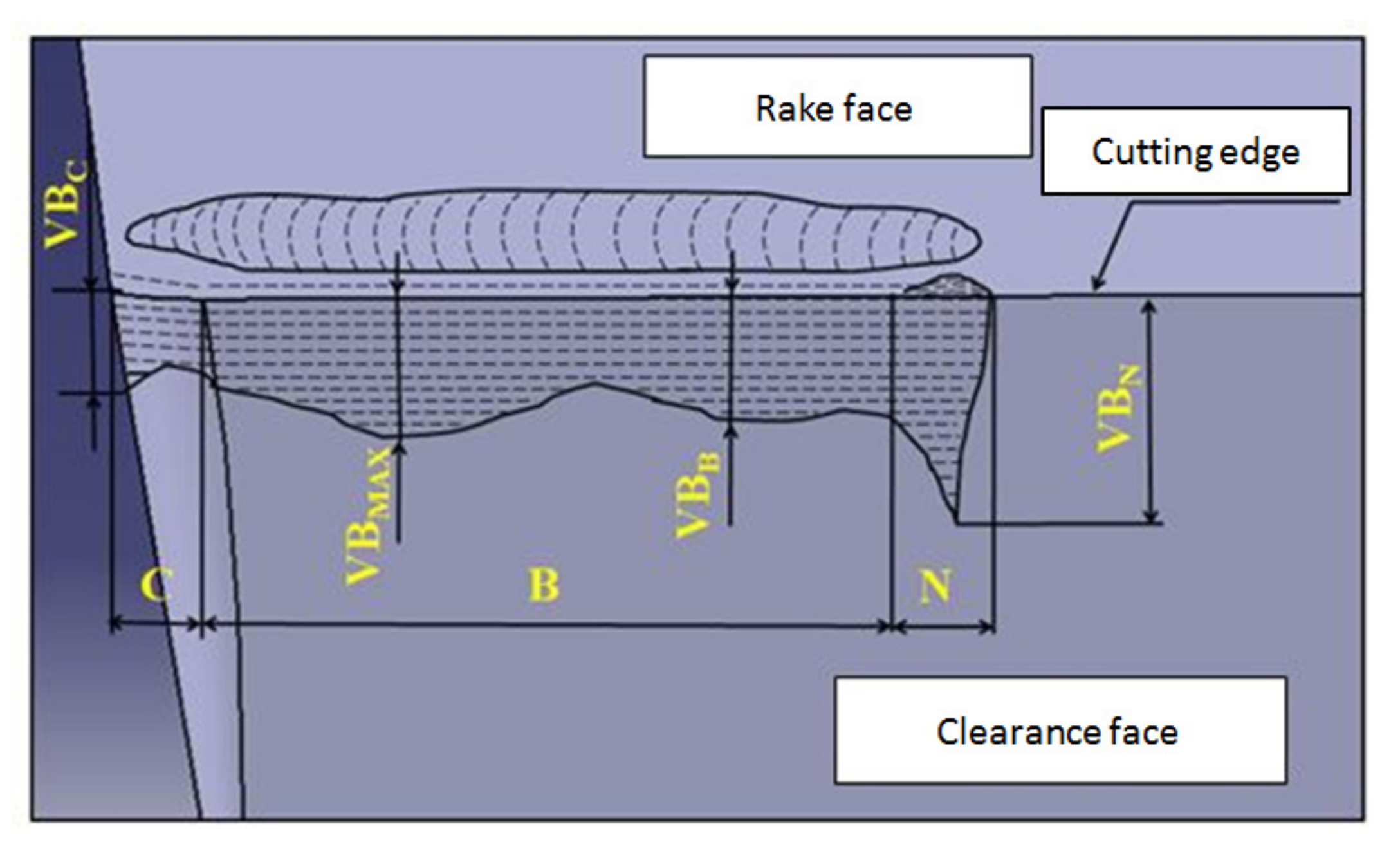
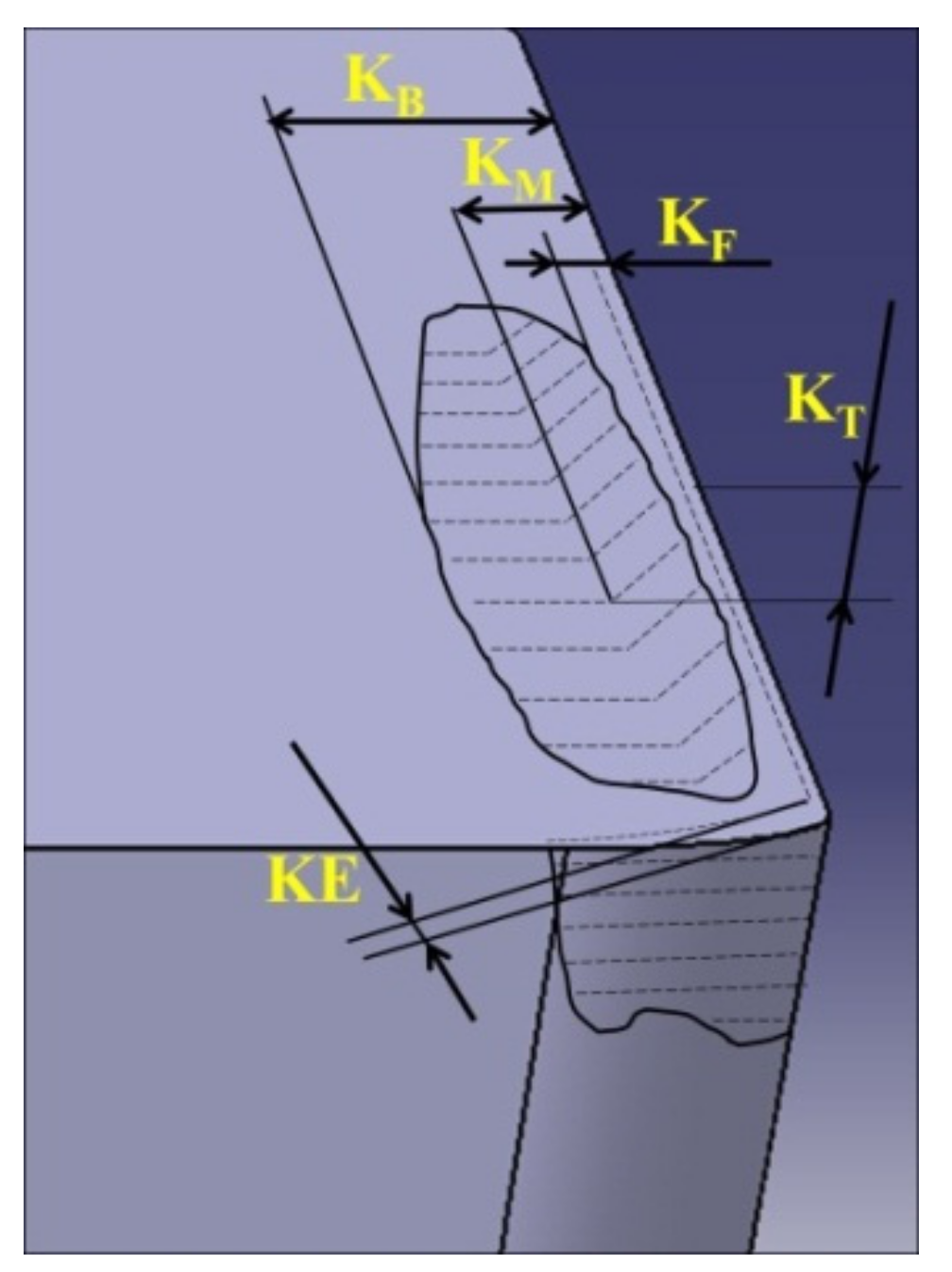
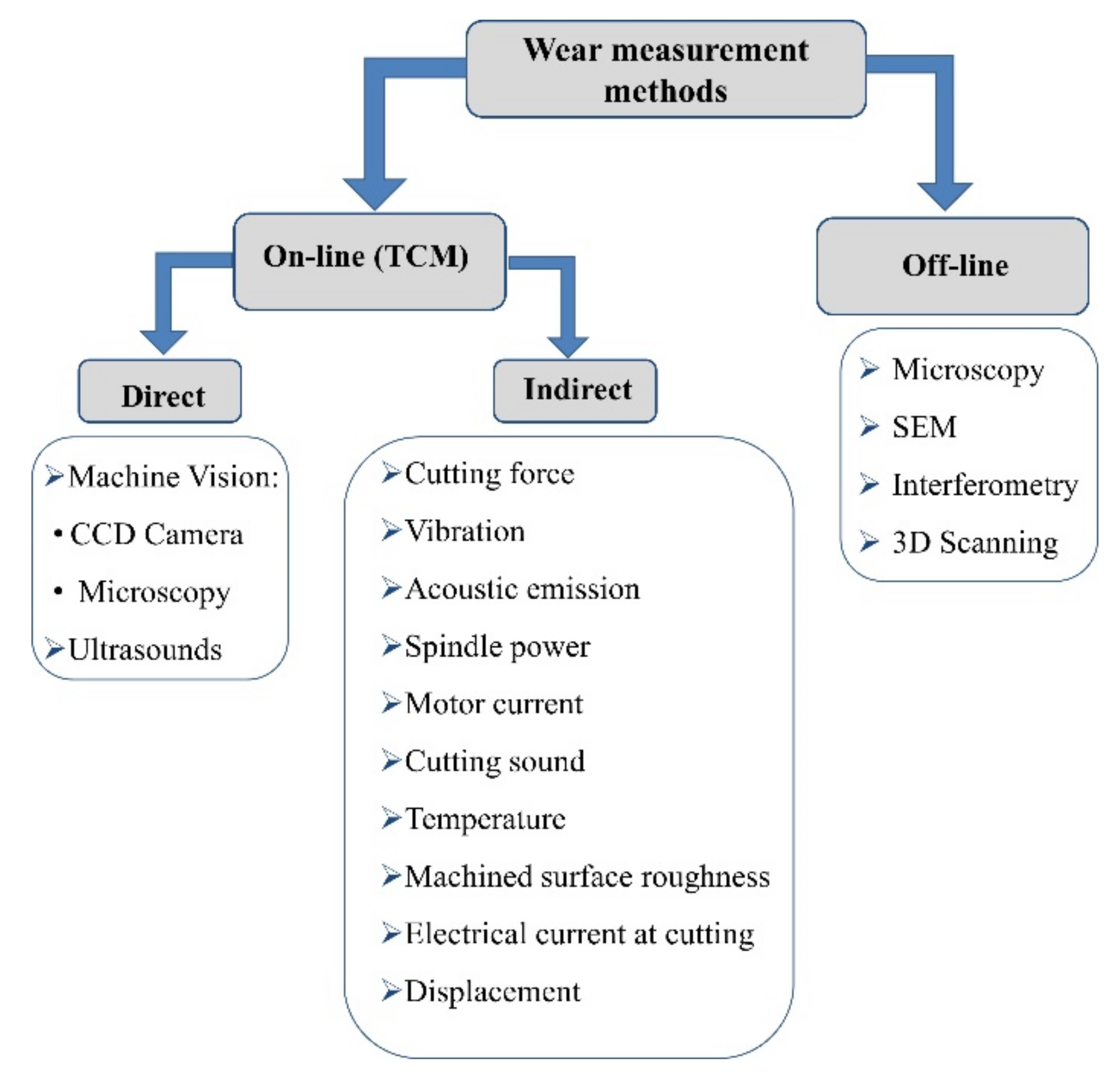
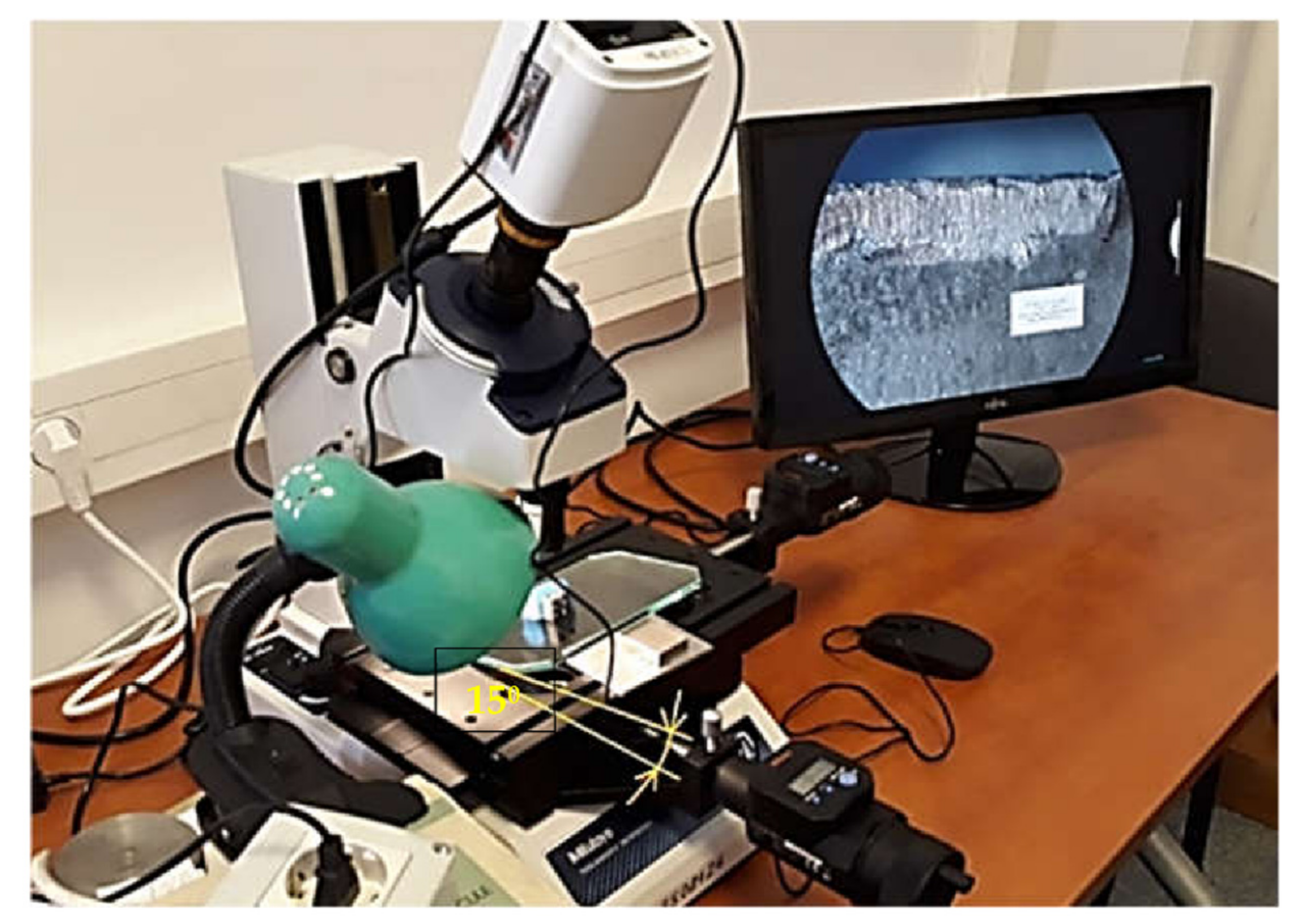

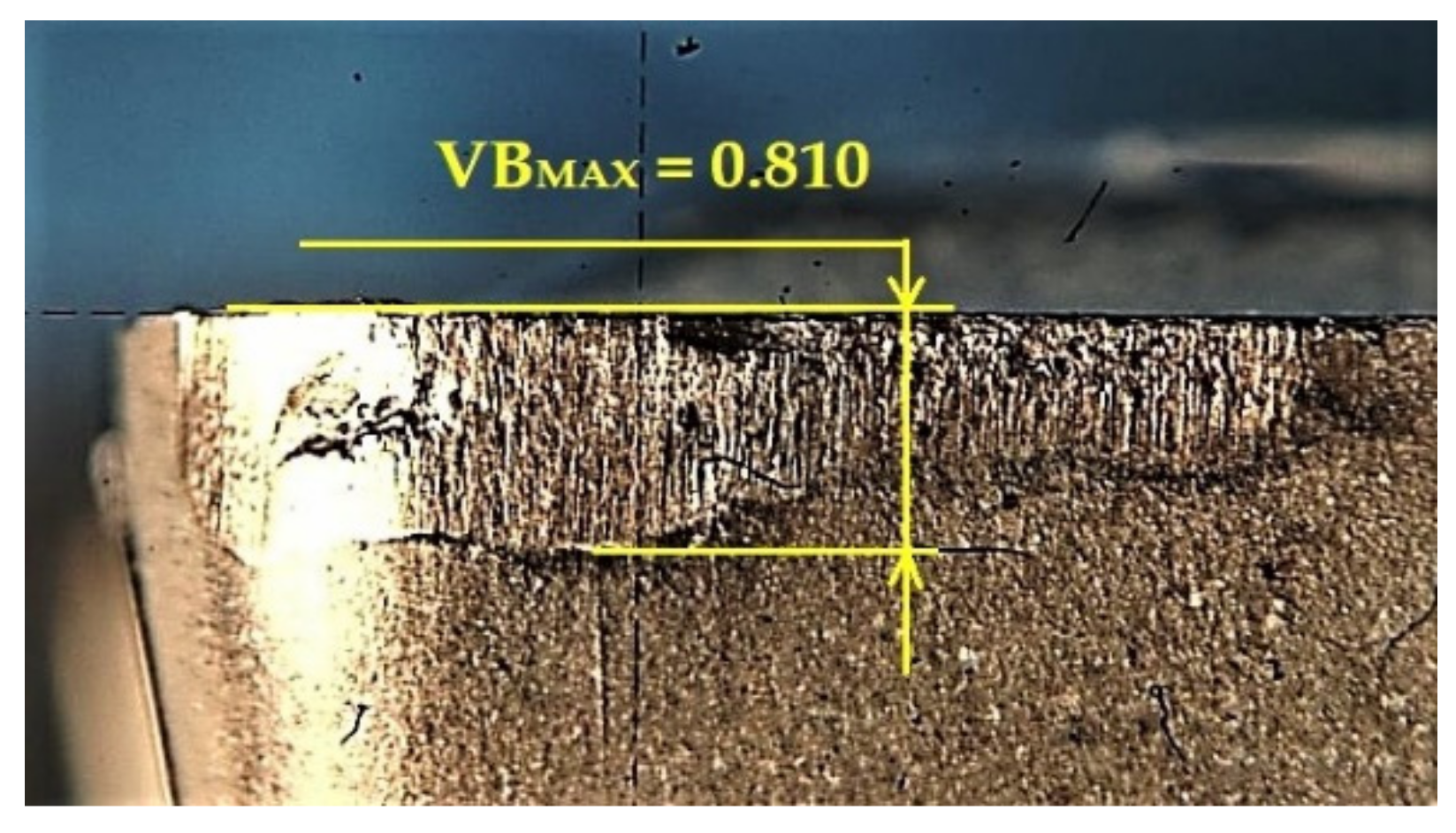
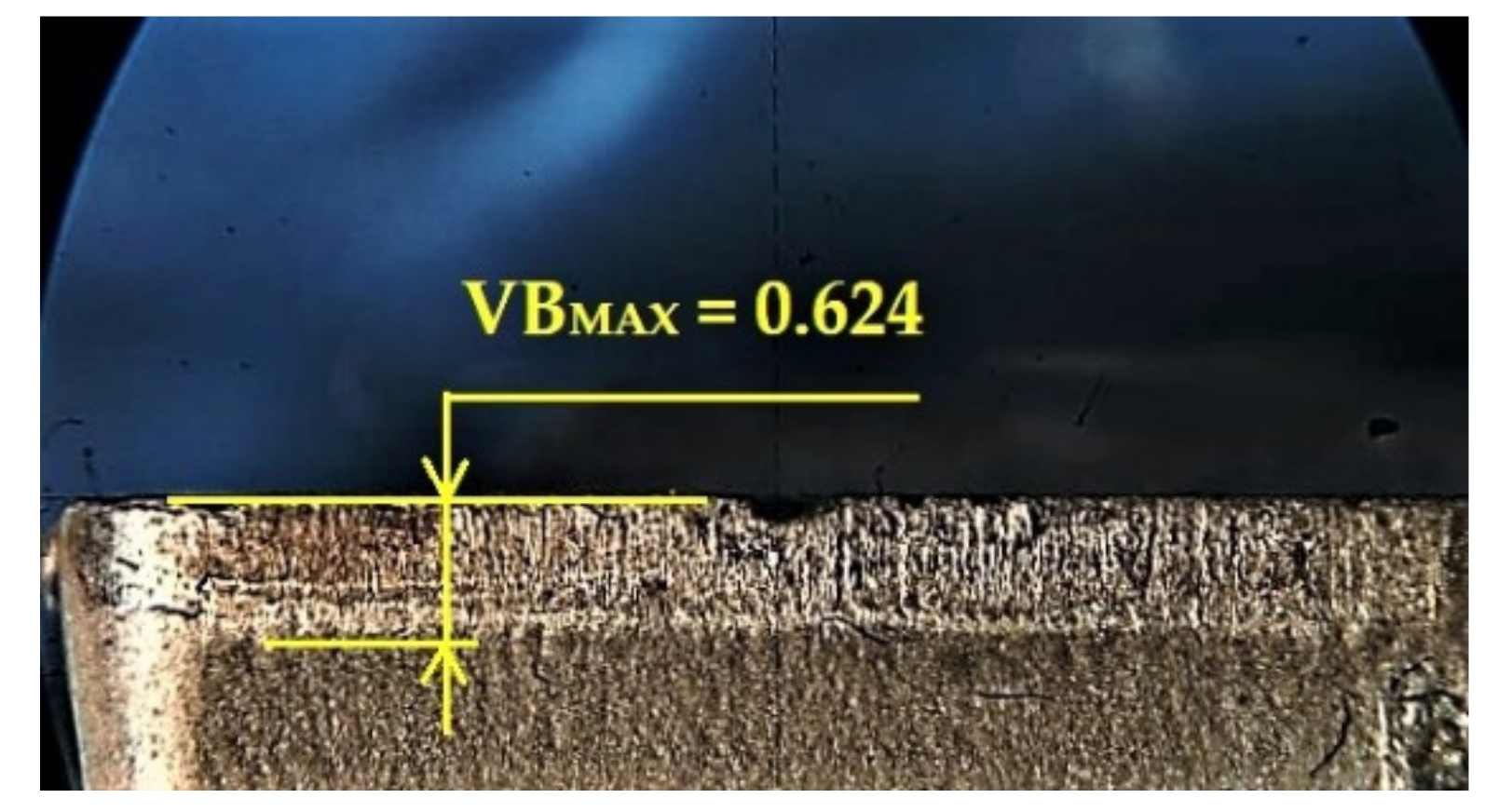
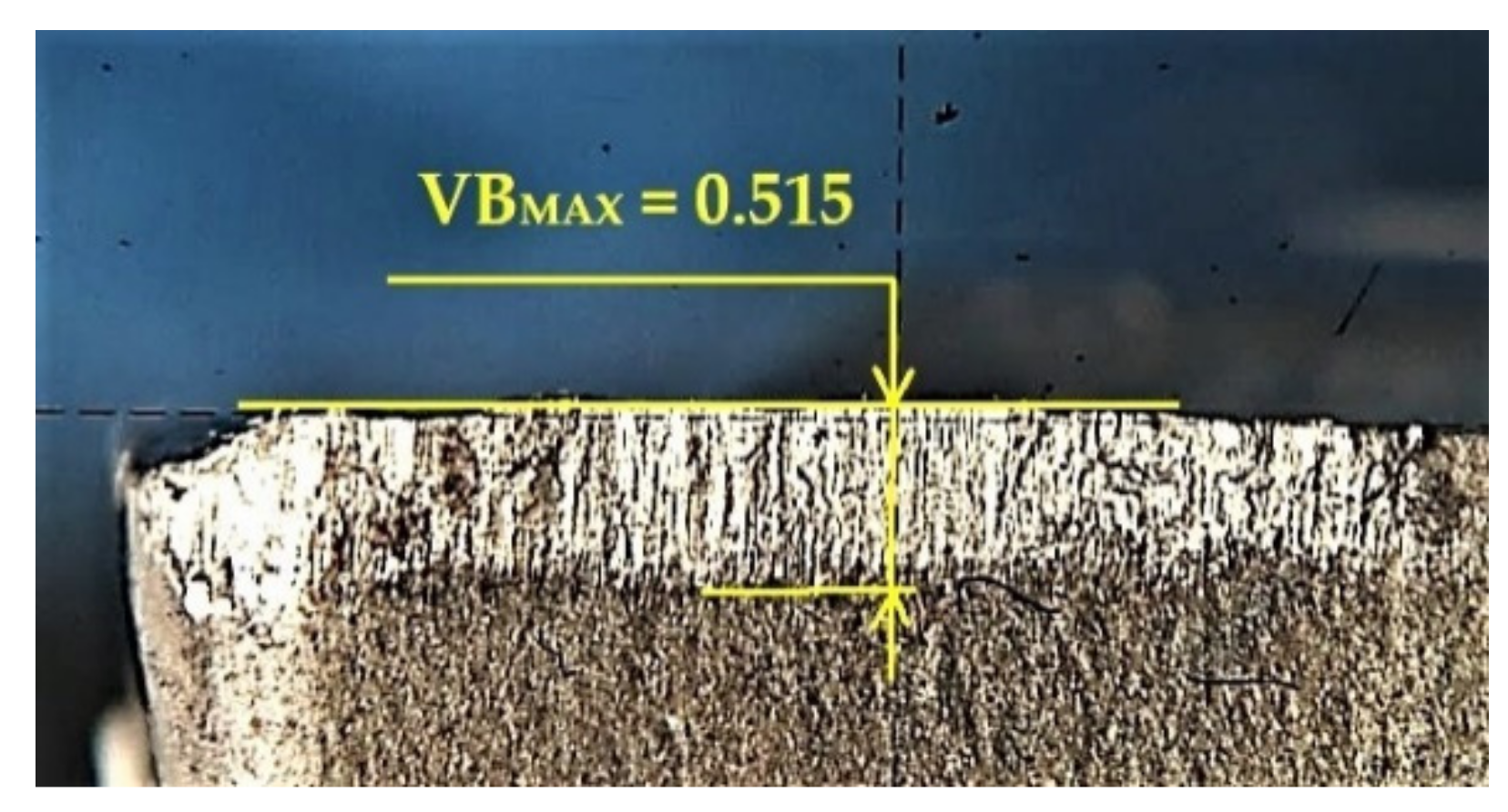
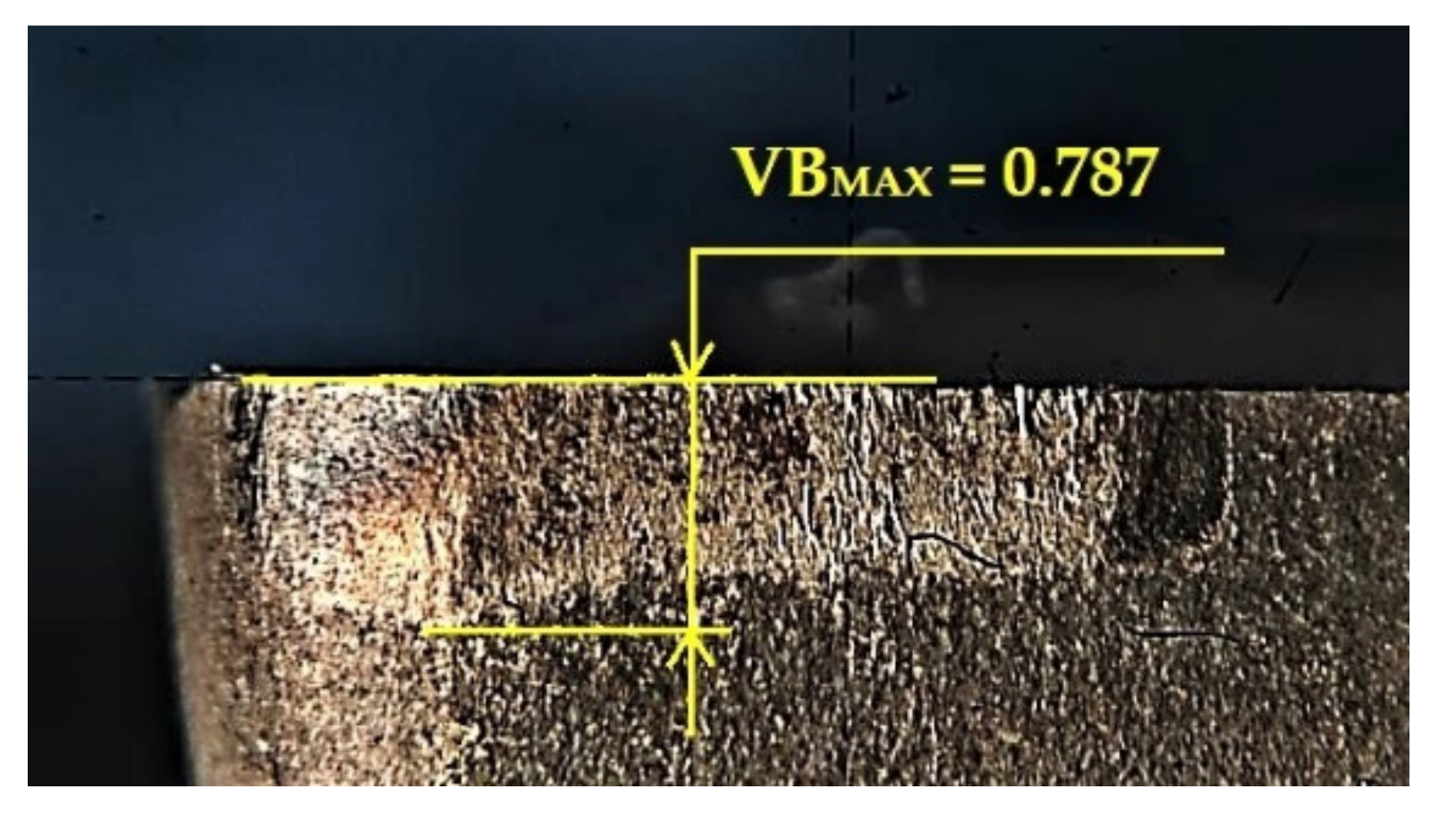

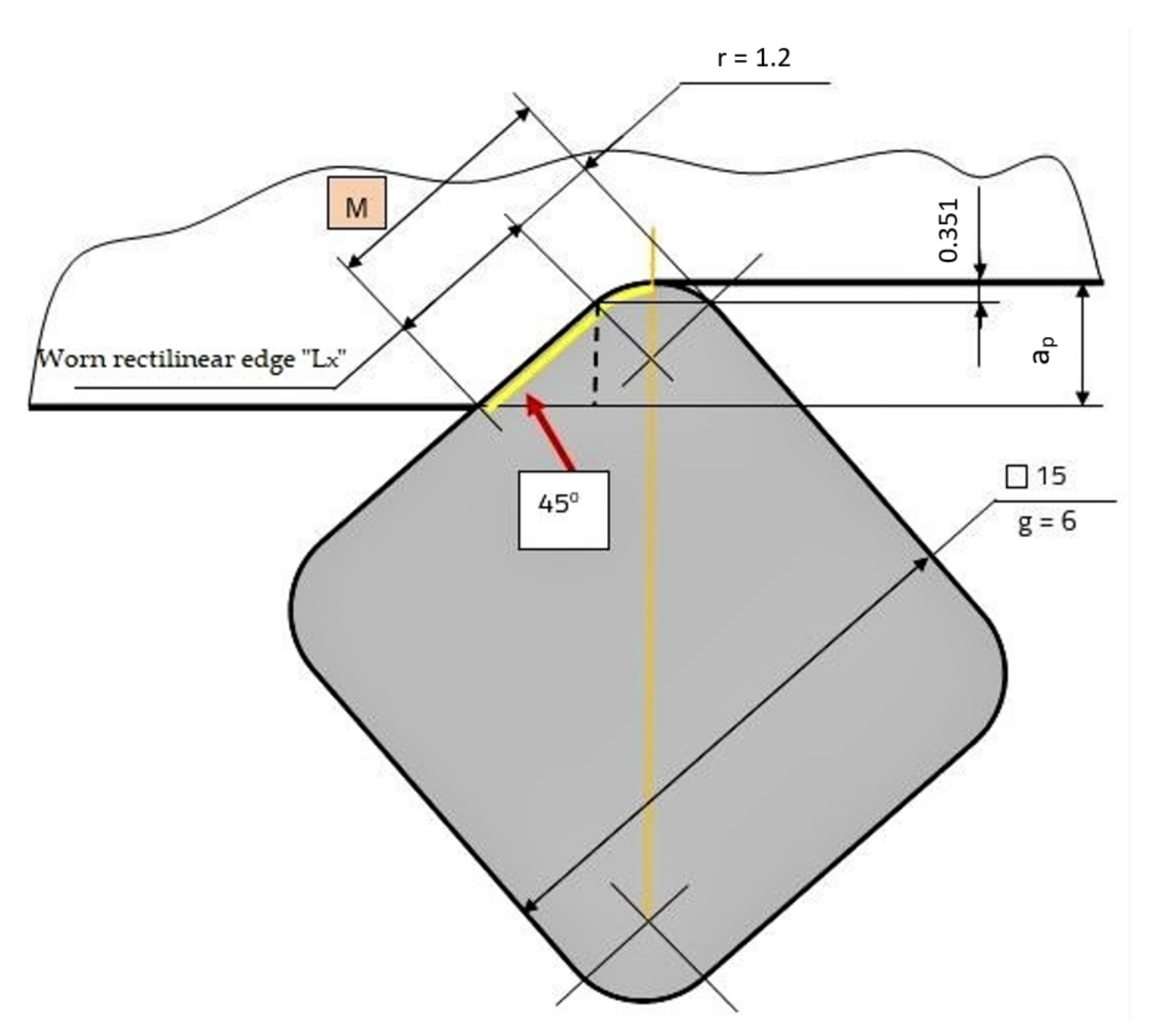
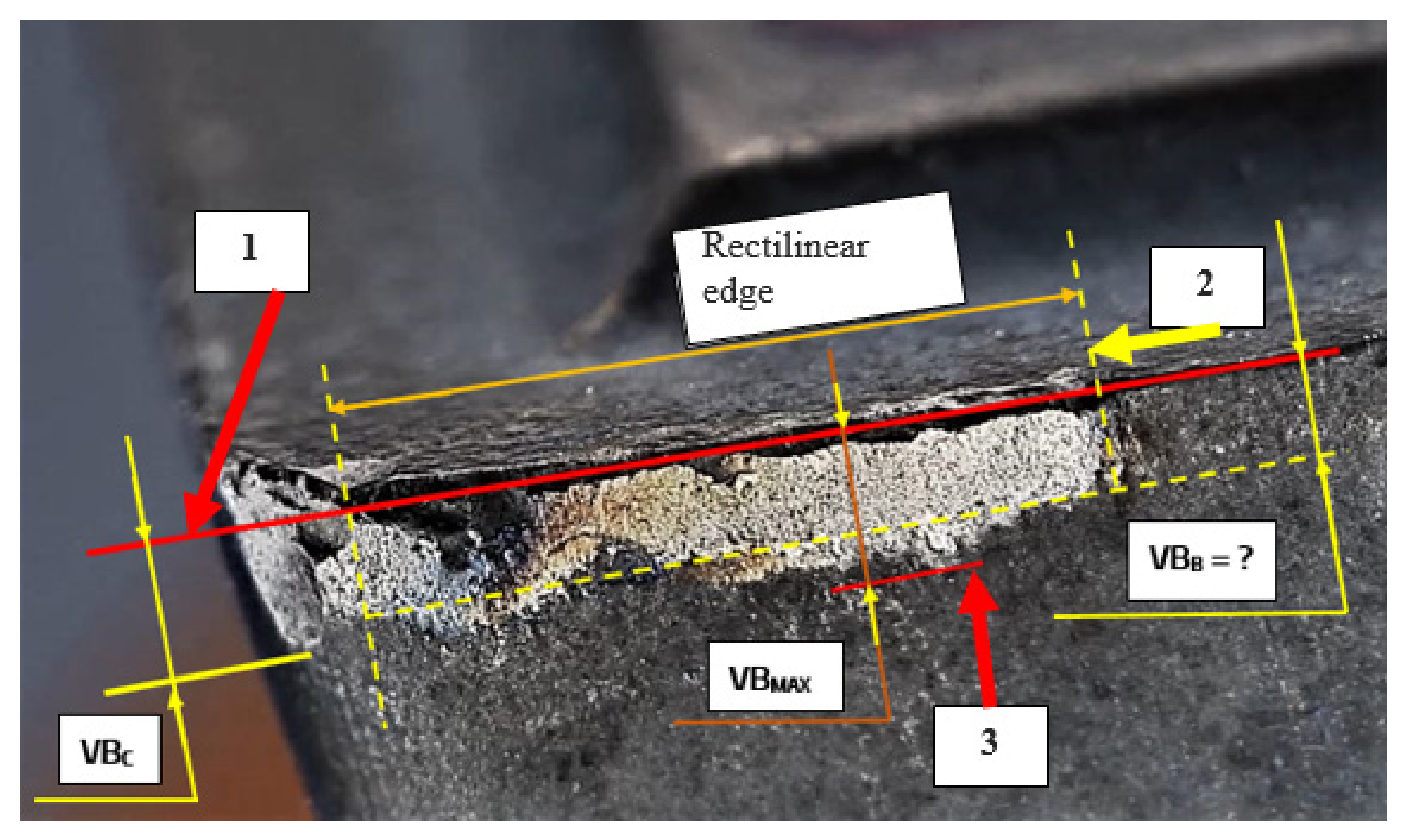
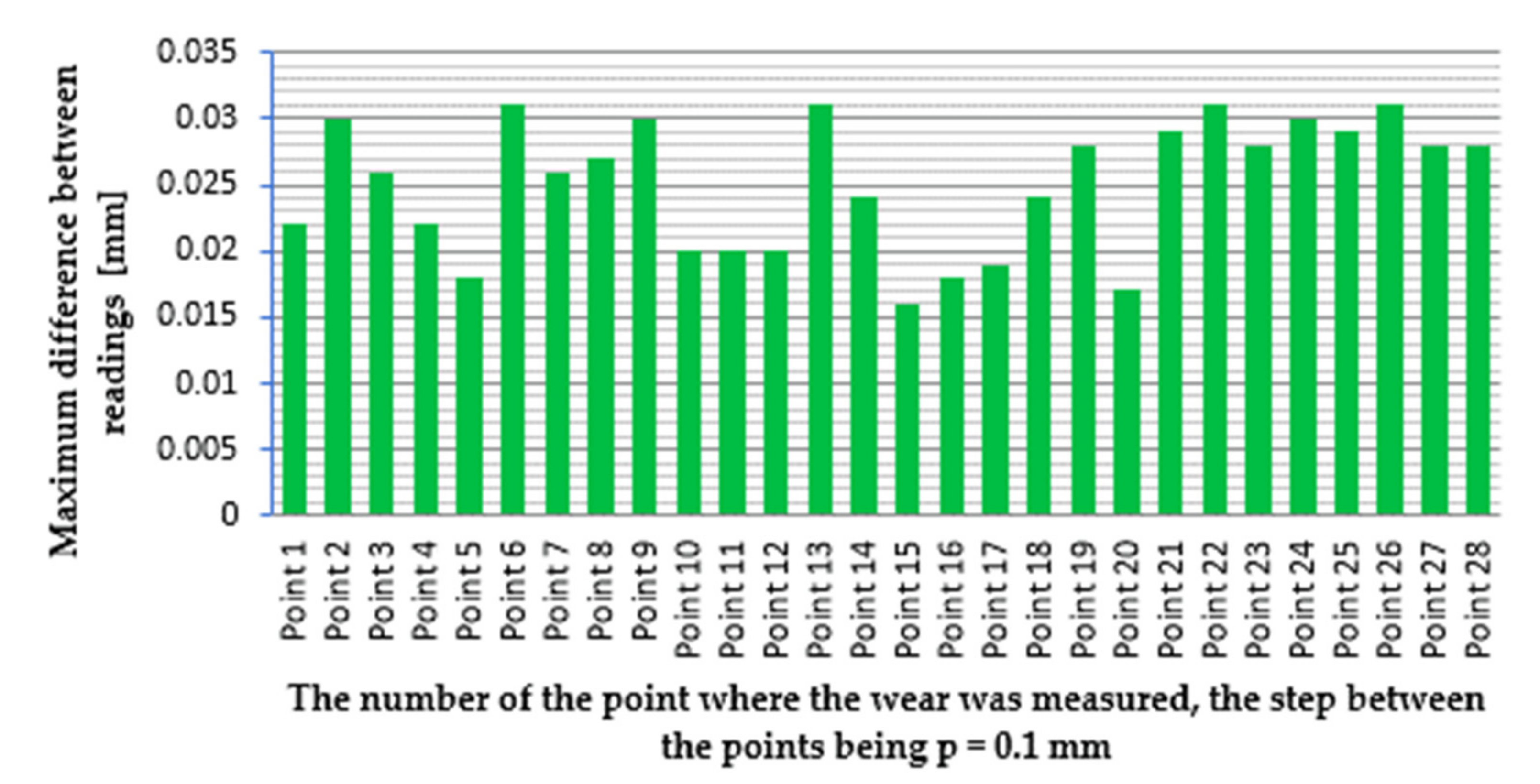
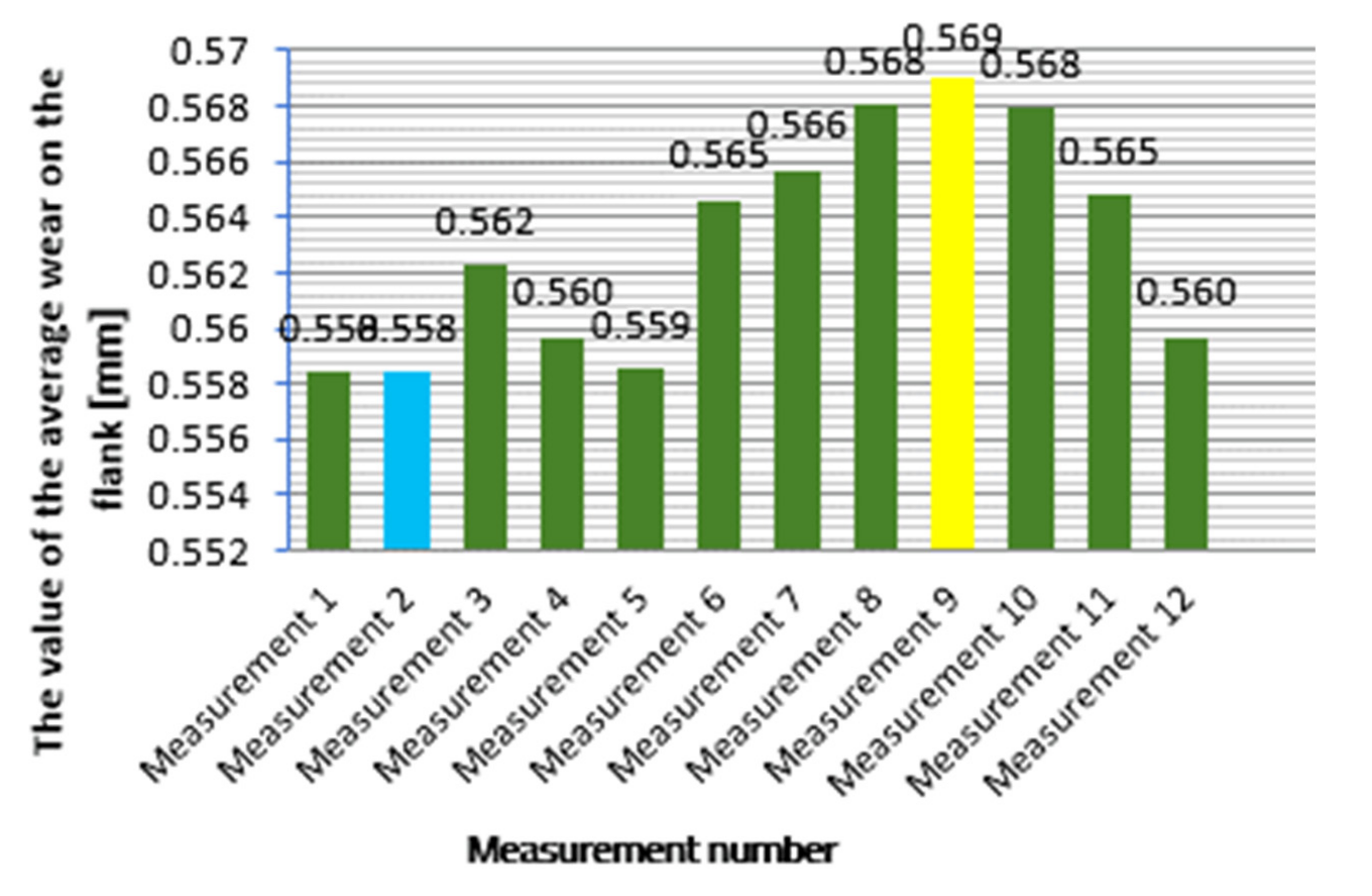
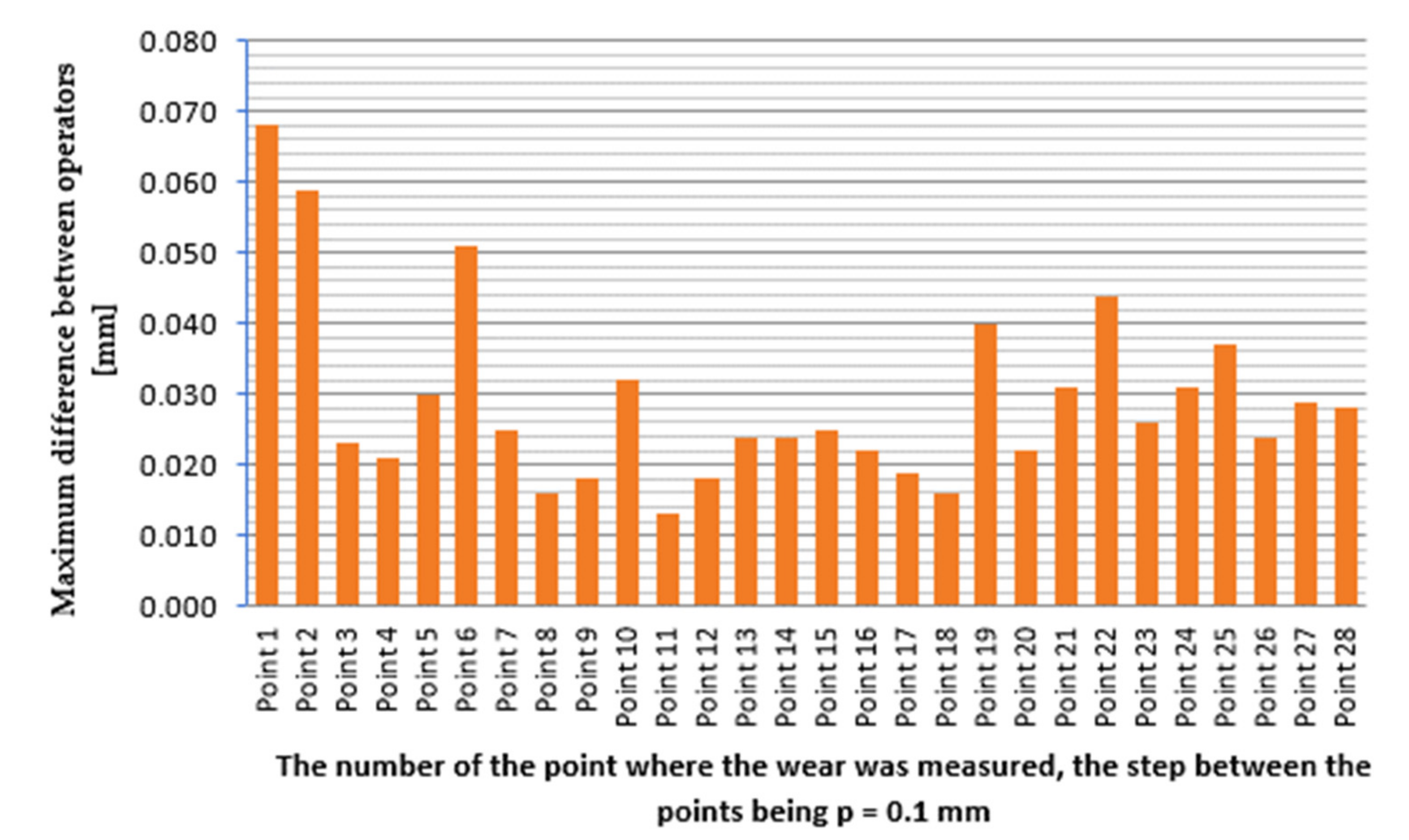

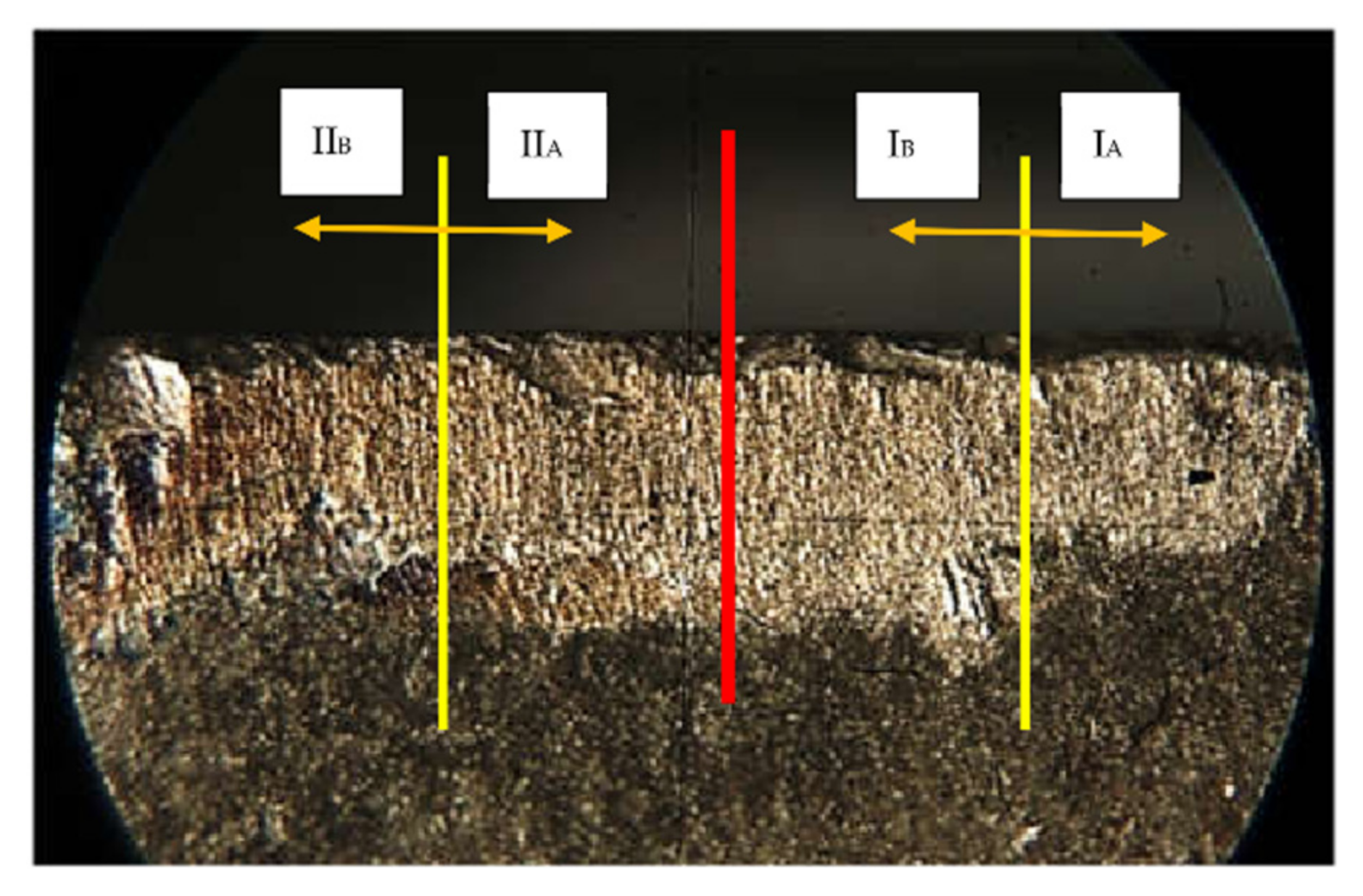
| Cutting Parameters No. Cutting Fluids | Cutting Insert 1 | Cutting Insert 2 | Cutting Insert 3 | Cutting Insert 4 | Cutting Insert 5 | Cutting Insert 6 |
|---|---|---|---|---|---|---|
| Cutting speed [m/min] | 106 | 106 | 106 | 106 | 106 | 106 |
| Feed rate [mm/rev] | 0.208 | 0.208 | 0.208 | 0.208 | 0.208 | 0.208 |
| Depth-of-cut [mm] | 2.25 | 2.5 | 4.4 | 3 | 2 | 2.5 |
| Repetition No. | Deviation from the First Positioning (mm) | Repetition No. | Deviation from the First Positioning (mm) | Repetition No. | Deviation from the First Positioning (mm) |
|---|---|---|---|---|---|
| 1 | 0.002 | 8 | −0.002 | 15 | −0.003 |
| 2 | 0.001 | 9 | 0.001 | 16 | −0.002 |
| 3 | 0.000 | 10 | 0.001 | 17 | 0.000 |
| 4 | 0.002 | 11 | −0.001 | 18 | 0.000 |
| 5 | 0.002 | 12 | 0.001 | 19 | 0.001 |
| 6 | −0.001 | 13 | 0.000 | 20 | −0.001 |
| 7 | 0.000 | 14 | 0.000 | ||
| Maximum difference from the first positioning | 0.003 | ||||
| The average difference from the first positioning | 0.0005 | ||||
| Maximum difference | 0.005 | ||||
| Repetition No. | Deviation from the First Positioning (mm) | Repetition No. | Deviation from the First Positioning (mm) | Repetition No. | Deviation from the First Positioning (mm) |
|---|---|---|---|---|---|
| 1 | −0.002 | 8 | −0.003 | 15 | 0.000 |
| 2 | −0.001 | 9 | −0.004 | 16 | 0.002 |
| 3 | 0.002 | 10 | −0.003 | 17 | 0.001 |
| 4 | −0.003 | 11 | 0.000 | 18 | −0.003 |
| 5 | 0.000 | 12 | 0.000 | 19 | 0.002 |
| 6 | −0.001 | 13 | 0.000 | 20 | 0.001 |
| 7 | −0.001 | 14 | 0.001 | ||
| Maximum difference from the first positioning | 0.004 | ||||
| The average difference from the first positioning | 0.0006 | ||||
| Maximum difference | 0.006 | ||||
| Edge No. | The No. of Points for Measuring the Wear | Wear Values VBB [mm] |
|---|---|---|
| 1 | 28 | 0.372; 0.450; 0.459; 0.472; 0.458; 0.483; 0.559; 0.652; 0.686; 0.595; 0.596; 0.608; 0.624; 0.599; 0.598; 0.604; 0.619; 0.593; 0.563; 0.570; 0.543; 0.458; 0.451; 0.499; 0.585; 0.643; 0.643; 0.654 |
| 2 | 31 | 0.110; 0.247; 0.467; 0.512; 0.536; 0.527; 0.530; 0.483; 0.465; 0.477; 0.493; 0.504; 0.502; 0.489; 0.511; 0.546; 0.584; 0.626; 0.640; 0.685; 0.708; 0.746; 0.797; 0.805; 0.804; 0.810; 0.779; 0.756; 0.747; 0.753; 0.764 |
| 3 | 58 | 0.423; 0.492; 0.494; 0.481; 0.521; 0.555; 0.545; 0.548; 0.550; 0.553; 0.567; 0.574; 0.533; 0.541; 0.547; 0.529; 0.534; 0.553; 0.555; 0.530; 0.542; 0.539; 0.536; 0.538; 0.517; 0.504; 0.515; 0.520; 0.514; 0.537; 0.541; 0.518; 0.538; 0.558; 0.547; 0.563; 0.546; 0.558; 0.545; 0.537; 0.560; 0.576; 0.562; 0.548; 0.563; 0.541; 0.560; 0.578; 0.562; 0.571; 0.582; 0.597; 0.624; 0.588; 0.579; 0.578; 0.594; 0.596 |
| 4 | 38 | 0.424; 0.433; 0.464; 0.434; 0.455; 0.401; 0.397; 0.406; 0.456; 0.472; 0.501; 0.454; 0.440; 0.447; 0.445; 0.466; 0.482; 0.455; 0.469; 0.478; 0.477; 0.474; 0.482; 0.515; 0.504; 0.478; 0.502; 0.468; 0.471; 0.467; 0.470; 0.438; 0.478; 0.503; 0.484; 0.582; 0.598; 0.578 |
| 5 | 25 | 0.424; 0.518; 0.545; 0.586; 0.612; 0.606; 0.616; 0.631; 0.622; 0.645; 0.662; 0.631; 0.654; 0.701; 0.665; 0.664; 0.695; 0.740; 0.757; 0.745; 0.733; 0.722; 0.749; 0.787; 0.782 |
| 6 | 31 | 0.591; 0.608; 0.634; 0.626; 0.609; 0.628; 0.673; 0.676; 0.713; 0.690; 0.661; 0.637; 0.641; 0.649; 0.639; 0.652; 0.650; 0.638; 0.662; 0.647; 0.685; 0.658; 0.654; 0.650; 0.664; 0.611; 0.613; 0.592; 0.610; 0.639; 0.443 |
| Edge No. | The No. of Points for Measuring the Wear | Average Wear VBB (mm) | Maximum Wear VBMAX (mm) | VBMAX/VBB |
|---|---|---|---|---|
| 1 | 28 | 0.558 | 0.686 | 1.229 |
| 2 | 31 | 0.647 | 0.810 | 1.252 |
| 3 | 58 | 0.547 | 0.624 | 1.141 |
| 4 | 38 | 0.463 | 0.515 | 1.112 |
| 5 | 25 | 0.660 | 0.787 | 1.192 |
| 6 | 31 | 0.637 | 0.713 | 1.119 |
| Edge No. | The No. of Points for Measuring the Wear | Average Wear VBB (mm) | Maximum Wear VBMAX (mm) | VBMAX/VBB | VBB,I (mm) | VBB,II (mm) | Superunit Ratio between VBB,I and VBB,II |
|---|---|---|---|---|---|---|---|
| 1 | 28 | 0.558 | 0.686 | 1.229 | 0.544 | 0.574 | 1.055 |
| 2 | 31 | 0.647 | 0.810 | 1.252 | 0.462 | 0.734 | 1.589 |
| 3 | 58 | 0.547 | 0.624 | 1.141 | 0.529 | 0.564 | 1.066 |
| 4 | 38 | 0.463 | 0.515 | 1.112 | 0.447 | 0.497 | 1.112 |
| 5 | 25 | 0.660 | 0.787 | 1.192 | 0.596 | 0.728 | 1.221 |
| 6 | 31 | 0.637 | 0.713 | 1.119 | 0.645 | 0.628 | 1.027 |
| Edge No. | The No. of Points for Measuring the Wear | Average Wear VBB (mm) | Maximum Wear VBMAX (mm) | VBMAX/VBB | VBB,A (mm) | VBB,B (mm) | Superunit Ratio between VBB,A and VBB,B |
|---|---|---|---|---|---|---|---|
| I | 14 | 0.544 | 0.686 | 1.261 | 0.465 | 0.623 | 1.340 |
| II | 14 | 0.573 | 0.654 | 1.141 | 0.584 | 0.562 | 1.039 |
Publisher’s Note: MDPI stays neutral with regard to jurisdictional claims in published maps and institutional affiliations. |
© 2022 by the authors. Licensee MDPI, Basel, Switzerland. This article is an open access article distributed under the terms and conditions of the Creative Commons Attribution (CC BY) license (https://creativecommons.org/licenses/by/4.0/).
Share and Cite
Daicu, R.; Oancea, G. Methodology for Measuring the Cutting Inserts Wear. Symmetry 2022, 14, 469. https://doi.org/10.3390/sym14030469
Daicu R, Oancea G. Methodology for Measuring the Cutting Inserts Wear. Symmetry. 2022; 14(3):469. https://doi.org/10.3390/sym14030469
Chicago/Turabian StyleDaicu, Raluca, and Gheorghe Oancea. 2022. "Methodology for Measuring the Cutting Inserts Wear" Symmetry 14, no. 3: 469. https://doi.org/10.3390/sym14030469







